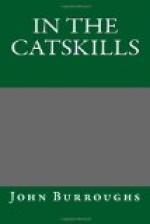Continuing my random walk, I next paused in a low part of the woods, where the larger trees began to give place to a thick second-growth that covered an old Barkpeeling. I was standing by a large maple, when a small bird darted quickly away from it, as if it might have come out of a hole near its base. As the bird paused a few yards from me, and began to chirp uneasily, my curiosity was at once excited. When I saw it was the female mourning ground warbler, and remembered that the nest of this bird had not yet been seen by any naturalist,—that not even Dr. Brewer had ever seen the eggs,—I felt that here was something worth looking for. So I carefully began the search, exploring inch by inch the ground, the base and roots of the tree, and the various shrubby growths about it, till, finding nothing and fearing I might really put my foot in it, I bethought me to withdraw to a distance and after some delay return again, and, thus forewarned, note the exact point from which the bird flew. This I did, and, returning, had little difficulty in discovering the nest. It was placed but a few feet from the maple-tree, in a bunch of ferns, and about six inches from the ground. It was quite a massive nest, composed entirely of the stalks and leaves of dry grass, with an inner lining of fine, dark brown roots. The eggs, three in number, were of light flesh-color, uniformly specked with fine brown specks. The cavity of the nest was so deep that the back of the sitting bird sank below the edge.
In the top of a tall tree, a short distance farther on, I saw the nest of the red-tailed hawk,—a large mass of twigs and dry sticks. The young had flown, but still lingered in the vicinity, and, as I approached, the mother bird flew about over me, squealing in a very angry, savage manner. Tufts of the hair and other indigestible material of the common meadow mouse lay around on the ground beneath the nest.
As I was about leaving the woods, my hat almost brushed the nest of the red-eyed vireo, which hung basket-like on the end of a low, drooping branch of the beech. I should never have seen it had the bird kept her place. It contained three eggs of the bird’s own, and one of the cow bunting. The strange egg was only just perceptibly larger than the others, yet three days after, when I looked into the nest again and found all but one egg hatched, the young interloper was at least four times as large as either




